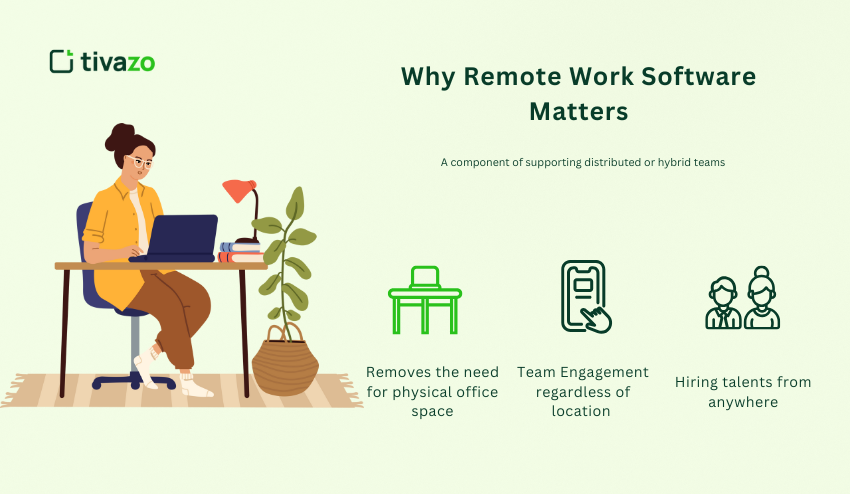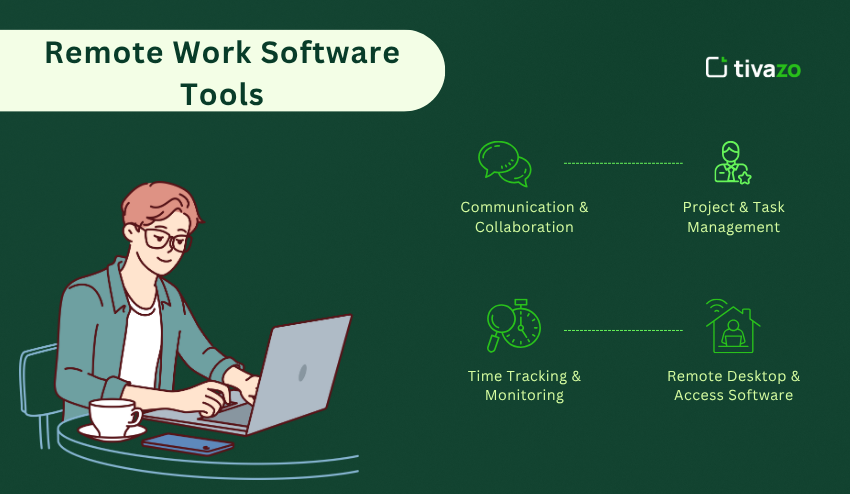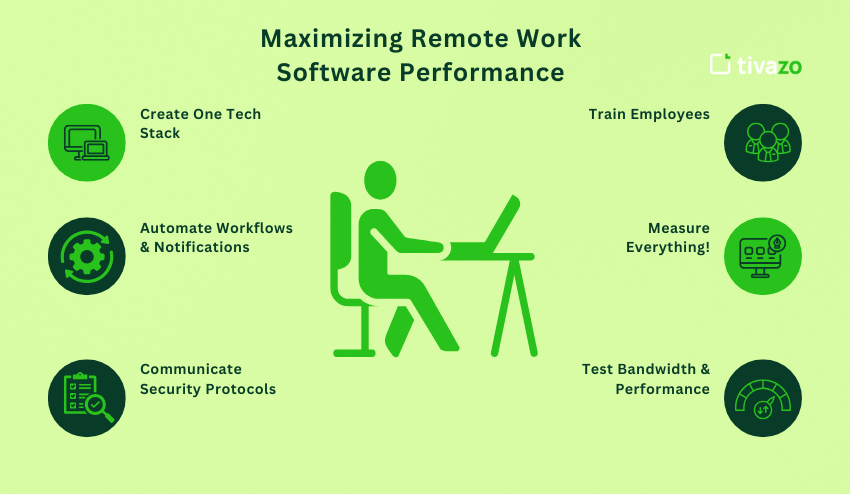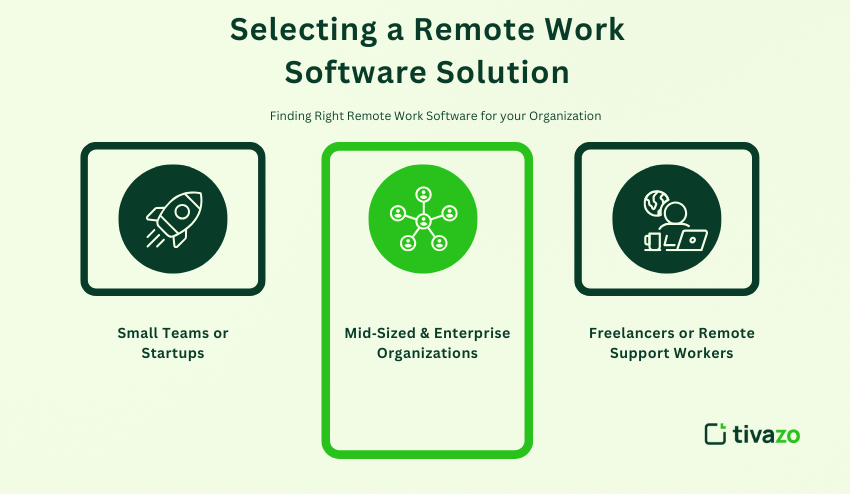Remote work software has become increasingly important for teams operating outside of traditional office spaces. As demand skyrocketed in 2025, highlighting the importance of selecting the right remote work software is vital to remain productive, connected, and secure. The following deep guide will cover everything from definitions, features that you should have, the top tools, ways to be productive, comparison of platforms, and advice. It does not matter whether you are a startup, freelancer, or enterprise; choosing the best tools directly aids in team flexibility, team morale, operational efficiencies, and sustainable long-term growth. You will learn how to develop a high-performing remote working ecosystem that suits your specific needs.
What Is Remote Work Software?
Remote work software refers to applications and tools that allow two or more people (teams, individuals) to communicate, collaborate, manage tasks, and access systems to remain productive while working from remote locations. Remote work software will consist of collaboration suites, video communication, chat tools, project/task tracking, cloud office suites, and remote access software.
Remote work software is the digital infrastructure that supports today’s modern workplaces. These systems become a replacement for in-office systems. If you need to manage deadlines through project management platforms, talk about ideas in a timely fashion via video calls, or you now need to securely access a work computer from your home, remote work software is necessary to make sure business operations can operate as efficiently as possible.
Why Remote Work Software Matters
A component of supporting distributed or hybrid teams
- Removes the need for physical office space.
- Ensures your teams are aligned, engaged, and efficient, regardless of location.
- Supports the business by enabling fast growth and hiring talent, anywhere, at less cost.
In an ever-connected and flexible work and digital culture, remote work software is an imperative, not just an option.

Must-Have Features in Remote Work Software
Remote work software needs to have the basic forms of connection for productive remote work, including
- Video conferencing/screen sharing (Zoom, Microsoft Teams)
- Instant messaging/chat (Slack, Teams)
- Cloud document collaboration (Google Workspace, Microsoft 365)
- Task & project management (Trello, Asana, ClickUp)
- Time tracking/activity monitoring (Hubstaff, ActivTrak)
- Secure remote access/desktop control (TeamViewer, AnyDesk, Zoho Assist)
- File sync, versioning, and secure sharing
- Integration enabling communication and automation with other business tools
These are foundational components of a solid remote work software stack.
In the digital office, integration is vital – for instance, being able to have your communication tool integrate with your project management apps or your time tracker to automatically interface with your payroll system enables true efficiency. Automation eliminates the manual aspect of repetitive tasks and allows teams to focus on higher-value work.
User experience and mobile access are also crucial considerations. The best remote work software will be intuitive, will require minimal training, and will have mobile apps for team members who like to work on the fly.
Data privacy and compliance features are also non-negotiable. Make sure the tools you choose support encryption capabilities, role-based access, and comply with regulations like GDPR or HIPAA – especially if your team uses sensitive information in a remote environment.
Most Important Remote Work Software Tools for Working Remotely
While some may take a guess, I have gone and reviewed and compared the up-to-date lists, if any, from Splashtop, Forbes, if you accepted user list data from Reddit, and many of the top remote work software as described below have proven indispensable.
1. Communication & Collaboration
Despite a wide range of tools available for instant messaging, team calls, and virtual meetings, I selected Slack, Microsoft Teams, and Zoom first because they are widely used today for allowing real-time updates across departments. Followed by Google Workspace, Notion, Canva, Trello, ClickUp, Asana, and Miro for collaboration tools. These tools cover any type of teamwork from co-editing documents to brainstorming and planning.
2. Project & Task Management
Tools like ClickUp, Trello, monday.com, ProofHub, and Asana allow teams to break down complicated projects into workable tasks, identifying what each team is responsible for, timelines, and status reports on progress visually. These tools are great for each team member knowing what each other is accountable for to address missed and other work packages.
3. Time Tracking & Monitoring
Hubstaff ranks as one of the best for time tracking, especially for remote teams or hybrid teams. Hundreds of remote employees of Hubstaff have remote employees. Captures screenshots, tracks active hours worked, and provides productivity reporting to help manage performance efforts and employee distribution of workloads.
4. Remote Desktop & Access Software
For IT teams and support specialists to computer systems to support respodence professional for teams can remote software solutions like AnyDesk, TeamViewer Remote, Zoho Assist, Splashtop, and RustDesk are reliable and secure t connect and remotely manage, setup computer systems, where you can help troubleshoot or assist users system, when a range of users may be located anywhere on the globe.

Key Categories of Remote Work Software
| Category | Example | Tools Benefits |
| Communication | Slack, Teams, Zoom | Instant messaging, meetings, virtual HQ |
| Project Management | Trello, ClickUp, Asana | Task tracking, milestones, visibility for all |
| Collaboration & Whiteboarding | Google Workspace, Miro, Notion | Real-time editing, visual brainstorming |
| Remote Access & Support | AnyDesk, TeamViewer, Zoho Assist, RustDesk | Screen/control, file sharing, IT support |
| Time Tracking & Monitoring | Hubstaff, ActivTrak | Productivity analytics, accountability |
This table provides a quick overview of the powerful remote work software available, helping readers to choose, depending on their team’s specific needs and workflows. Whether your focus is large-scale project planning, seamless communication, or secure remote access, each category is essential for developing a complete remote experience. Overall, when you invest in a combination of these products, you not only improve your productivity but also provide long-term scalability and employee satisfaction.
Selecting software from these categories is a way for companies to develop a balanced and integrated tech stack to help support collaboration, efficiency, and performance, no matter where your teams are working.
What is the best platform for remote jobs?
If you are a job hunter, you are probably wondering: “What’s the best platform to find remote jobs? Which platform fits our remote work software?” As the digital workspace grows, it is becoming more important to select platforms that make quality jobs available and allow the modernization of tech stacks.
Top Remote Job Platforms
Here are some top-tier platforms known to have quality jobs for remote positions across all kinds of industries:
- We Work Remotely – a popular remote-only job board that has industry-specific jobs for developers, marketers, designers, and many more.
- Remote OK – aggregates tech-centric jobs within some well-known global companies, while also showcasing any job opportunities that are a part of a remote-first culture or technology stack.
- FlexJobs – vetting each remote job so that you don’t have to do the legwork, and they also have hybrid and freelancing job opportunities.
- AngelList Talent – startups hiring remotely often use recommend liabilities with Trello, Slack, Notion, etc.
- LinkedIn (with remote filter) – very useful for assessing what companies are looking for, what skills other respondents had, as well as which companies recognize that’s an arm’s length with their remote tools.
Companies Leading Remote Work
- GitLab – 100% remote, with internal reliance on GitLab, Zoom, Slack, and Notion.
- Automattic – publisher of WordPress, and fully remote with internal reliance on P2 (Internal tool), Slack, and Zoom.
- Deel – Deel hiring and payroll compliance for employer-of-record contracting on a global basis, compliant with popular remote work technology integrations.
- Toptal – a freelancer firm that matches users to elite clients, normally utilizing Hubstaff and ClickUp.
Top Characteristics of the Best Remote Job Platforms
- Promote companies and their adoption of good remote work software
- Allows filtering by tool experience (for instance, “must know Trello, Slack”)
- Showcase culture, tech stack, and remote policies
- Provide content and support to help remote career growth
Whether someone is seriously interested in working remotely in 2025 and the future, these platforms provide the highest level of access to jobs that rely on remote work tools.
Fundamental Characteristics of the Best Remote Job Boards
Highlight companies with a strong embrace of remote technology
- Allow filtering by software skill level, etc. (e.g, “must know Trello, Slack”)
- Highlight company culture, tech stack, and remote work practices
- Provide articles and resources around advancing a remote work career
For anyone who is serious about working remotely in 2025 and beyond, these boards will provide the best access to jobs that leverage remote work tools.
When selecting remote access solutions, you should consider ease of use, security, as well as ease of integration with other tools. Each offers its advantages:
- AnyDesk is great for freelancers and small teams because of its fast response times and ease of use. And, its security guarantees that data is encrypted end-to-end, making it ideal for secure settings.
- TeamViewer Remote supports a variety of devices and includes augmented reality (AR) tools, and therefore is well suited for more complex uses in enterprise settings.
- Zoho Assist has features such as session recording, multi-monitor control, and browsing for close contacts for SME’s or customer service teams.
- RustDesk, as an open-source option, is a good choice for privacy drivers or techies looking for purpose-built local solutions for full attention over their data from first access.
These solutions mix flexibility with portability, which makes them a go-to option for remote IT support, software maintenance, or to walk through remote infrastructure.
Maximizing Remote Work Software Performance
You can optimize remote work software by following the above recommendations.
1. Create One Tech Stack
Make sure the remote work software works together correctly [i.e., Slack + Google Drive + ClickUp + Hubstaff + AnyDesk].
2. Automate Workflows & Notifications
You can use automation applications too (Workato, Z, etc.) to send Slack notifications when tasks are updated or time-tracking screenshots are pending review.
3. Communicate Security Protocols
You can use 2-factor authentication, AES‑256 encryption, endpoint-control software like AnyDesk or TeamViewer to enforce and communicate with your remote access security policies.
4. Train Employees
Provide onboarding sessions to train employees in remote software use and expectations – Zoom etiquette, Slack channels, Trello & project triage, Hubstaff time-tracking.
5. Measure Everything!
You can use metrics for backtracking, reviewing productivity boards, login rates, and software adoption. There are great analytics in Hubstaff, Teams Insight, and built-in reports.
6. Test Bandwidth & Performance
Use applications that perform well on normal home internet services – you can create lightweight remote access applications with AnyDesk/RustDesk that don’t take away from employee usability.

Selecting a Remote Work Software Solution
Here are some suggestions to find the right remote work software solution for your organization:
For Small Teams or Startups
Combined, it is a stack – Slack + Trello + Google Workspace + AnyDesk or Zoho Assist + Hubstaff (basic plan).
Advantages: inexpensive, rapid onboarding, features all in slim packages.
For Mid‑Sized & Enterprise Organizations
Integrated / unified suites: Microsoft Teams / ClickUp / Asana / Miro + enterprise-wide remote access + TeamViewer; time tracking like ActivTrak or Hubstaff Pro.
Advantages: scalable, secure, centralized governance and support.
For Freelancers or Remote Support Workers
Lean stack: Zoom, Slack, Chrome Remote Desktop or AnyDesk, Google Drive, Trello.
Advantages: cheap, portable stack, flexible.

Conclusion
By procuring the right remote work software, you’ll not only make your business processes more streamlined but also keep your team connected, organized, and productive across time zones. With the right tool, policies, and practices, businesses can improve collaborative working (and reduce miscommunication) and improve accountability even within fully remote or hybrid working models, no matter where team members are. It’s important to regularly audit your software stack to ensure that you’re focusing not only on meeting today’s challenges but also tomorrow’s scalability and innovation.
As remote work continues to trend upward, companies that invest in agile, secure, well-integrated tools will lead the occupation in operational productivity and employee satisfaction. Make sure to stay ahead of the competition by choosing to support the tools that will integrate well into your workflow and company goals.
It’s also important to train employees to utilize the remote work software to its fullest. Even with the best remote software, it does not make a difference if the employee does not put in the time to adopt and use the software. Solicit feedback from employees and set a time each week for one-on-one and/or group training, and work to constantly optimize your tech stack dashboard so you, as a remote company, can build a seamless remote work experience that drives performance satisfaction and your long-term business success.



